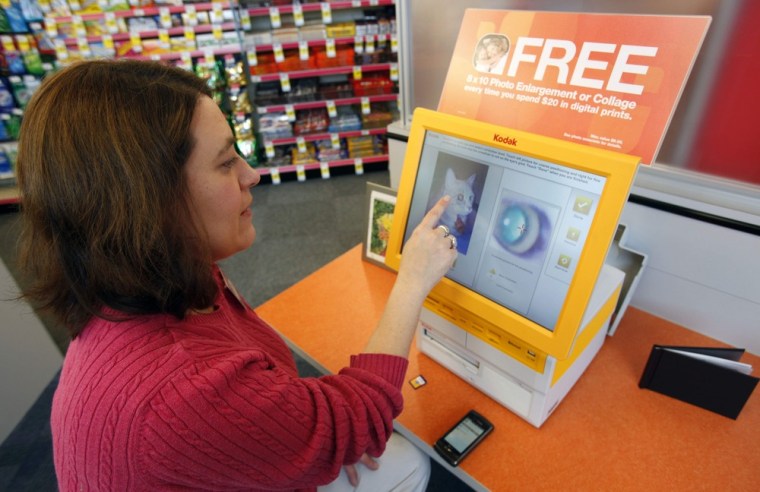Eastman Kodak Co. has a new trick for its retailer kiosks: a hassle-free way to create photo collages that fit various frames with precut cardboard mats.
The picture-taking pioneer has been scrambling to counter eroding profits from photo processing over the last decade by reeling in custom-photo customers via retail channels. In typical fashion, its PYNK Smart Print system will try to catch the eye of the hustling masses.
"We're opening up a whole new print-to-fit category," said Rowan Lawson, a marketing director in Kodak's consumer digital group. "It goes back to Kodak's DNA: 'You press the button, we do the rest.'
"With the advent of digital photography, nobody has properly solved putting multiple photos together at the press of one button. If you don't make it that simple, it's not going to happen."
Kodak unveiled the new kiosk software Monday on the eve of Photokina, the world's largest photo-products trade show held annually in Cologne, Germany. The company has installed 100,000 self-service kiosks at retail businesses worldwide since 1993 and will roll out the collage option beginning Dec. 1 at 5,000 CVS/pharmacy stores nationwide.
The patented technology automatically enlarges, shrinks, crops, aligns and arranges as many as 13 images on one print.
The catch? The system is packaged to pull in a tidy profit. Aside from the collage, customers must also purchase a mat with anywhere from two to 13 slots for photos of various sizes, or a frame with a mat. A 6-by-8-inch print plus an 8-by-10 frame will retail for $17; an 8-by-10-inch print and mat will cost $11.
"I would not balk at the price," said Barbara Koff, a cosmetics sales consultant in White Plains, N.Y., who bought a framed collage as a surprise gift for her niece during a three-month Kodak trial run this summer at 32 drugstores in Westchester County, near New York City.
"It's very quick, very easy, and you feel you've created something you'd have to pay $50, $60 to do in a photography store," Koff said. "It put the smaller pictures that weren't as important to me in the smaller slots and the ones I wanted larger were a little bit enlarged. It's almost like the machine knew."
Kodak plans partnerships with frame makers offering a variety of frame sizes and mat configurations.
In the tumultuous digital era, the print side has been through a rocky decade. The number of digital and film images converted into conventional prints has tumbled from a peak of 30.3 billion in 2000 to around 17.7 billion in 2009, according to Photo Marketing Association International.
Overall revenues are rising, however, as alternatives to traditional 4-by-6-inch snapshots blossom, from putting computer reproductions of images onto posters and postcards to T-shirts and bronze plaques. U.S. sales in the specialty market soared from $738 million in 2006 to $1.3 billion last year, said Gary Pageau, the Jackson, Mich.-based trade group's publisher.
"Most creative collage systems in the market don't really take the presentation into account — you create the collage but then you have to mount or frame it," Pageau said. "Kodak is taking it all the way to the wall."
In both film and digital arenas, products that offer "an extraordinarily easy, high quality, end-to-end solution" usually win out, and photo collages catch the imagination, Pageau said. "When you're at a family event, there's not just one picture, there's typically two or three that really describe the scene."
Store kiosks already offer instant collage-photo creations of all sizes, with machines operated by Kodak rival Fujifilm capable of assembling multiple pictures on a poster-size, 24-by-36-inch print.
"Our designs are laid out such that there's borders, and different creative points within that, so you don't really need to mat it — it looks pre-matted when you put it in the frame," said Lenny Marano, a senior product manager in Fujifilm North America Corp.'s imaging division.
What sets Kodak's technology apart is its ability to produce prints that "perfectly fit the frame you have in your hand," said Kimberly Hajec, a Kodak marketing program manager.
"It zooms, crops and positions, and makes sure the faces are centered within each of those holes," she said. "The science behind this is the physical frame. The frame industry has built many, many different styles around matting, so we know they appeal to consumers, and Kodak is now making it easy for consumers to fill those frames."
